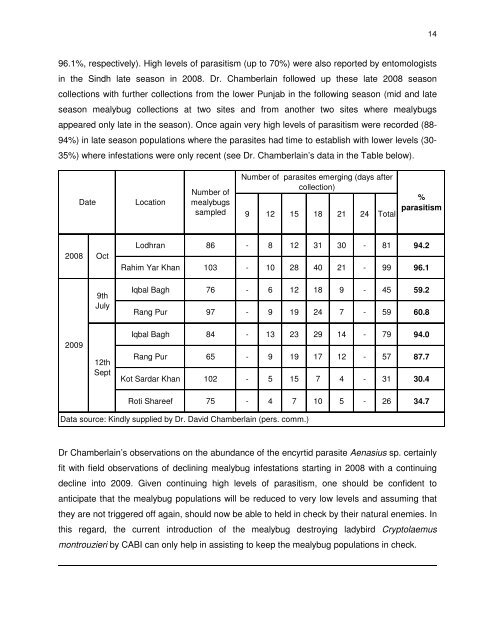ChangingCottonLandscapeNeilForrester
ChangingCottonLandscapeNeilForrester
ChangingCottonLandscapeNeilForrester
Create successful ePaper yourself
Turn your PDF publications into a flip-book with our unique Google optimized e-Paper software.
96.1%, respectively). High levels of parasitism (up to 70%) were also reported by entomologists<br />
in the Sindh late season in 2008. Dr. Chamberlain followed up these late 2008 season<br />
collections with further collections from the lower Punjab in the following season (mid and late<br />
season mealybug collections at two sites and from another two sites where mealybugs<br />
appeared only late in the season). Once again very high levels of parasitism were recorded (88-<br />
94%) in late season populations where the parasites had time to establish with lower levels (30-<br />
35%) where infestations were only recent (see Dr. Chamberlain’s data in the Table below).<br />
2008 Oct<br />
2009<br />
Date<br />
9th<br />
July<br />
12th<br />
Sept<br />
Location<br />
Number of<br />
mealybugs<br />
sampled<br />
9 12 15 18 21 24 Total<br />
Lodhran 86 - 8 12 31 30 - 81 94.2<br />
Rahim Yar Khan 103 - 10 28 40 21 - 99 96.1<br />
Iqbal Bagh 76 - 6 12 18 9 - 45 59.2<br />
Rang Pur 97 - 9 19 24 7 - 59 60.8<br />
Iqbal Bagh 84 - 13 23 29 14 - 79 94.0<br />
Rang Pur 65 - 9 19 17 12 - 57 87.7<br />
Kot Sardar Khan 102 - 5 15 7 4 - 31 30.4<br />
Roti Shareef 75 - 4 7 10 5 - 26 34.7<br />
Data source: Kindly supplied by Dr. David Chamberlain (pers. comm.)<br />
Number of parasites emerging (days after<br />
collection)<br />
14<br />
%<br />
parasitism<br />
Dr Chamberlain’s observations on the abundance of the encyrtid parasite Aenasius sp. certainly<br />
fit with field observations of declining mealybug infestations starting in 2008 with a continuing<br />
decline into 2009. Given continuing high levels of parasitism, one should be confident to<br />
anticipate that the mealybug populations will be reduced to very low levels and assuming that<br />
they are not triggered off again, should now be able to held in check by their natural enemies. In<br />
this regard, the current introduction of the mealybug destroying ladybird Cryptolaemus<br />
montrouzieri by CABI can only help in assisting to keep the mealybug populations in check.


